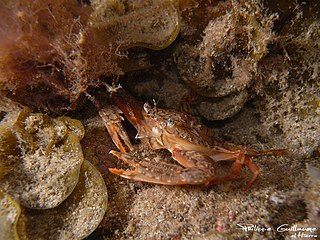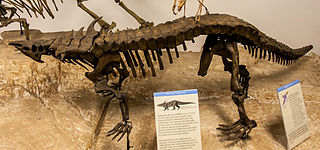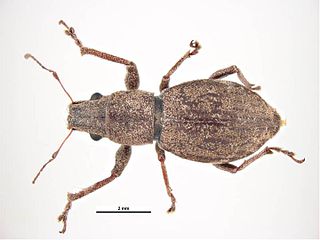
Portunus is a genus of crab which includes several important species for fisheries, such as the blue swimming crab, Portunus pelagicus and the Gazami crab, P. trituberculatus. Other species, such as the three-spotted crab (P. sanguinolentus) are caught as bycatch.

Soft-shell crab is a culinary term for crabs that have recently molted their old exoskeleton and are still soft. Soft-shells are removed from the water as soon as they molt to prevent any hardening of their shell. This means that almost the entire animal can be eaten, rather than having to shell the animal to reach the meat. The exceptions are the mouthparts, the gills and the abdominal cover, which, though edible when shells are very soft, are usually discarded ("cleaned"). The remaining, edible part of the crab is typically deep fried or sautéed.

Acacia, commonly known as the wattles or acacias, is a large genus of shrubs and trees in the subfamily Mimosoideae of the pea family Fabaceae. Initially, it comprised a group of plant species native to Africa and Australasia, but it has now been limited to contain only the Australasian species. The genus name is New Latin, borrowed from the Greek ἀκακία (akakia), a term used by Dioscorides for a preparation extracted from the leaves and fruit pods of Vachellia nilotica, the original type of the genus. In his Pinax (1623), Gaspard Bauhin mentioned the Greek ἀκακία from Dioscorides as the origin of the Latin name.
Dasygnathus is a genus of large scarab beetles found in Australia.

Desmatosuchus is an extinct genus of archosaur belonging to the Order Aetosauria. It lived during the Late Triassic.

Portunus trituberculatus, the gazami crab, South Korea's blue crab or horse crab, is the most widely fished species of crab in the world. It is found off the coasts of East Asia and is closely related to Portunus armatus.

Bolinus brandaris, and commonly known as the purple dye murex or the spiny dye-murex, is a species of medium-sized predatory sea snail, an edible marine gastropod mollusk in the family Muricidae, the murex snails or the rock snails.
Hematodinium perezi is an internal dinoflagellate parasite that infects crustaceans, including blue crabs, and causes bitter crab disease. Other crustaceans that have been observed to be infected include the Norway Lobster and King Crab, and has been observed to have a significant impact on crustacean fisheries. Infected crabs frequently show signs of weakness and lethargy, and often die due to stress-related handling from fishing as well as metabolic exhaustion due to reduced feeding. H. perezi is a type species of the genus Hematodinium, and perezi has only recently been identified as the specific parasitic dinoflagellate infecting crustaceans. In the east coast of the United States, the disease is most prevalent in the autumn months when the H. Perezi species blooms off the Mid-Atlantic coast. Infected crabs have been observed to have mortality rates as high as 86 percent after only a few weeks, and infection is found to be more prevalent in higher salinity waters towards the mouth of the bay where Callinectes go to spawn, generally 12 PSU and up.

Crab fisheries are fisheries which capture or farm crabs. True crabs make up 20% of all crustaceans caught and farmed worldwide, with about 1.4 million tonnes being consumed annually. The horse crab, Portunus trituberculatus, accounts for one quarter of that total. Other important species include flower crabs, snow crabs (Chionoecetes), blue crabs, edible or brown crabs, Dungeness crab, and mud crabs, each of which provides more than 20,000 tonnes annually.
Hematodinium is a genus of dinoflagellates. Species in this genus, such as Hematodinium perezi, the type species, are internal parasites of the hemolymph of crustaceans such as the Atlantic blue crab and Norway lobster. Species in the genus are economically damaging to commercial crab fisheries, including causing bitter crab disease in the large Tanner or snow crab fisheries of the Bering Sea.

Euodynerus is a genus of potter wasps with a mainly Holarctic distribution, though a number of species extend through Indomalayan, Australasian, Afrotropical and northern Neotropical regions. Also, a single species is reported from Hawaii.
Edward John Miers FZS FLS was a British zoologist and curator of the crustacean collection at the Natural History Museum in London. He contributed to the scientific reports from the Challenger expedition of 1872–1876, and described 32 new genera and at least 260 new species and subspecies of decapod crustaceans, along with four genera and 72 new species in other orders.

Bolinus is a genus of sea snails, marine gastropod mollusks in the family Muricidae, the murex snails or rock snails.

Achaeus is a genus of crabs comprising the following species:

Potemnemus is a genus of longhorn beetles of the subfamily Lamiinae, containing the following species:

Toxonotus is a genus of fungus weevils in the beetle family Anthribidae. There are about 13 described species in Toxonotus.

Thanatophilus is a genus of carrion beetles in the family Silphidae. There are about 12 described species in Thanatophilus.
Zaglyptus is a genus of ichneumon wasps in the family Ichneumonidae. There are at least 20 described species in Zaglyptus.

Pantomorus is a genus of broad-nosed weevils in the beetle family Curculionidae. There are more than 40 described species in Pantomorus.













